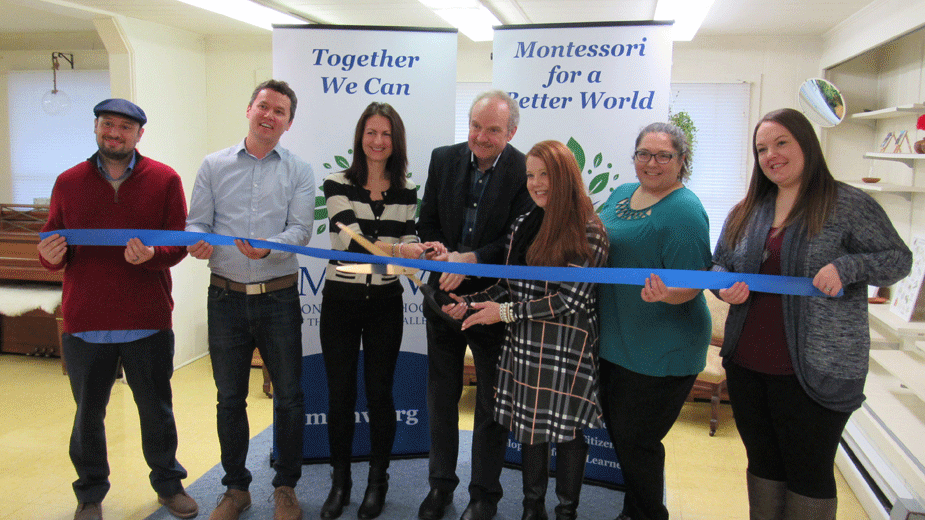Montessori Expansion Stems from ‘Good Roots’
YOUNGSTOWN, Ohio – With roots going back to the mid-1990s, two new buildings at the campus of the Montessori School of the Mahoning Valley officially opened Friday.
Two newly added buildings to the campus of The Montessori School of the Mahoning Valley this year have roots dating back to the mid-1990s.
When architect Tom Zebrasky, now retired, found the blueprints for Stettler House, which originally housed the school’s adolescent program in 1997, he decided to give them to Rachel Gonatas, the school’s executive director.
This led him to come out of retirement and readopt the role he had 23 years ago.
“It was totally unexpected,” Zebrasky said. “Last year, I was driving past [the school] and I gave the prints to Rachel. She was so happy to get the prints. … It was a nice project for me because it didn’t involve a lot of heavy construction.”
The buildings that Zebrasky and his team, which included Stephen Berry, president and principal architect at Architectural Design Inc. in Youngstown, house the upper elementary and adolescent programs. Between both buildings, upward of $300,000 was invested to make room for an additional 40 students, Gonatas said.
Having more classroom space benefitted both existing and new students, Gonatas said. Added to the buildings, designed to be handicap accessible, were bathrooms, hallways, a library, computer lab and a kitchen. In addition, a new classroom space and a place where students could hang their coats were added, she said.
“We needed to not only be able to allow more students to come, but be able to retain our current students in the facilities that we had,” Gonatas said at a ribbon cutting ceremony Friday morning. “The amount of work that went into this was phenomenal for Montessori because we’re all about prepared environments.”
Originating in Italy, Montessori is a philosophy of education that’s been around for 150 years, Gonatas said. The method takes a hands-on approach to learning. The Mahoning Valley Montessori teaches students, 116 of them, through eighth grade. It employs 18.
“I used to hate geometry, but when I started doing Montessori training, it all clicked to me because everything is hands-on,” said Amanda Kudak, head upper elementary teacher at Montessori.
On a typical day, students come in with individualized work plans, Kudak said. There’s a lot of freedom, but it still has limits, she said.
“They have this time to work, but they can’t be drawing the whole time,” Kudak said. “They need to be working on a set amount of things, but it’s their choice of how long they can work on it and how far they progress.”
The new buildings give Montessori a college campus feel to it, Kudak said. Students are broken up into groups, but they are still working together, she said. Each week, two of Kudak’s students go to the primary preschool program to help other students with their reading. Her students also serve as greeters when parents pick up and drop off their children, she said.

“You really get to know the students and you have a connection with them,” Kudak said. “If they’re struggling, you know how to help them and you get to build that relationship with the parents. I feel like it’s hard when you only have children for a year because the first part of the year, you have to get to know them and by the time you do, they leave.”
Some of the things that are different from traditional learning in Montessori include children being taught practical living skills and respect, Gonatas said. Teachers work with students for three years, which helps them understand students’ progress in the classroom.
“In upper elementary, it’s fourth, fifth and sixth grade,” Kudak said. “They’re all in one room and they’re all working on different things. My job is to make sure they’re on task and given appropriate work. It’s a hidden gem and the fact that we’re growing, it gives more children a chance.”
In most traditional environments, students walk in and it’s all about the teacher and what they have prepared for their students, Gonatas said. With Montessori, the child’s interests are followed, she said as she pointed to an example her daughter created.
“My daughter wasn’t really interested in learning about maps, but the teacher knew she was creative,” she said. “She had [my daughter] trace her foot and she had her make her own map, which was of Mermaid Island and Cotton Candy Falls. [My daughter] came home that day and she was like, ‘Mommy I learned about culture and maps,’ and she was drawn to it everyday after that.”
Both of Zebrasky’s children went to Montessori, and they could only go as far as fifth grade because there was no room, he said. But, what they learned set a lot of wheels in motion in their young heads. Today, they are local engineers with master’s degrees, he said.
“It all stemmed from good roots,” Zebrasky said.
Pictured: At the ribbon cutting for the Montessori School expansion are trustee Martin Zenobi, board vice president AJ Sumell, board president Kristin Jaskiewicz, architect Tom Zebrasky, school director Rachel Gonatas, trustee Janice Ranger and director of advancement Stephanie Crain.
Copyright 2024 The Business Journal, Youngstown, Ohio.



